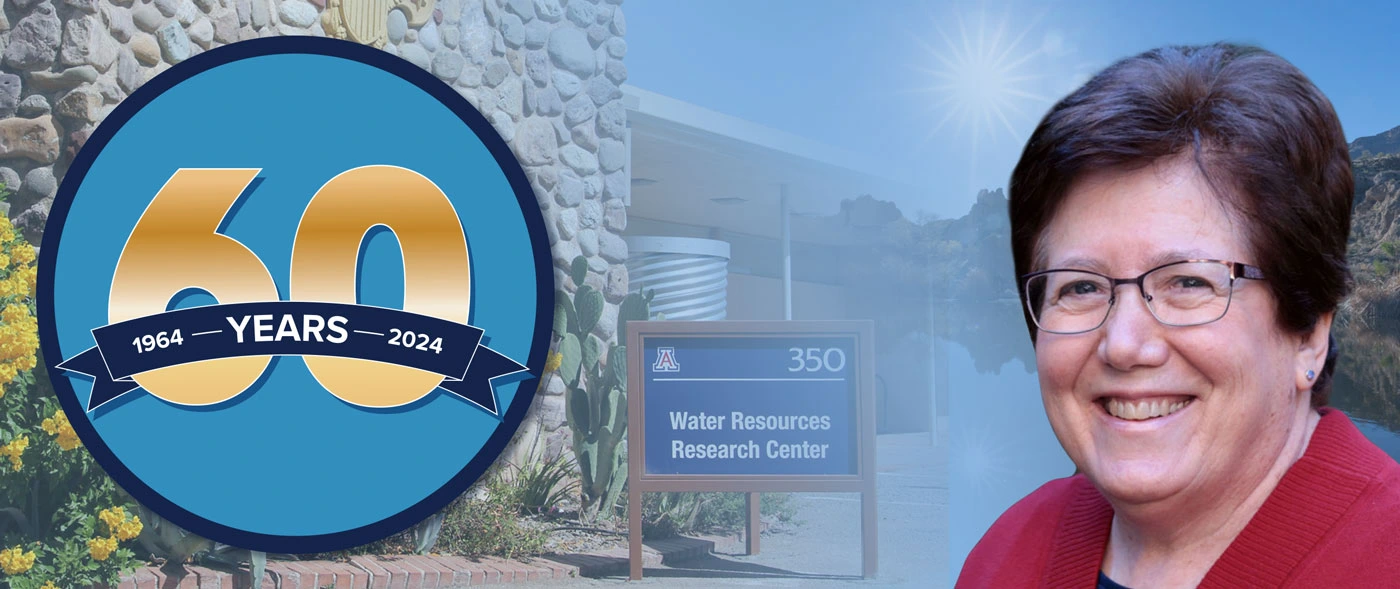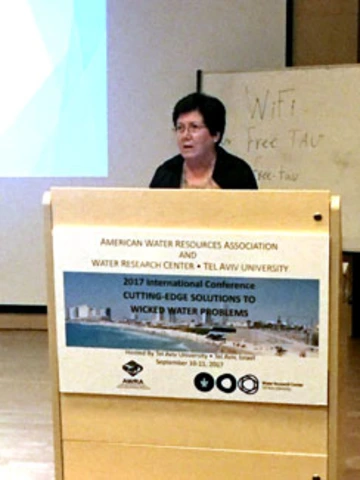
This summer marks a key milestone for the University of Arizona Water Resources Research Center. On July 17, 1964, President Lyndon B. Johnson signed the Water Resources Research Act, which established the WRRC as the federally authorized Water Resources Research Institute for Arizona. This summer therefore marks the WRRC’s 60th Birthday!
Ten years ago, when the WRRC turned 50, we published a 50-year overview as an insert to our Spring 2014 newsletter. Along with much else, the insert included information on the backgrounds and priorities of the six individuals who led the WRRC during its first 50 years. Richard Kassander (1920–2017), the founding Director, was a physicist who later became the University of Arizona’s Vice President for Research. During his tenure, “[w]ater pollution, development and evaluation of water harvesting systems, efficient disposal of effluents, and artificial recharge were some of the areas studied.” Sol Resnick (1918–2005) served as WRRC Director for 12 years and “oversaw research focused on water resources conservation, augmentation, and management in arid and semi-arid areas, including artificial groundwater recharge and water harvesting systems.” His many contributions were recognized with the Hydrology Lifetime Achievement Award from the University of Arizona. In 2003, the WRRC conference room was named in his honor. During the tenure of William (Bill) Lord (1929–2020), “the WRRC focused research on water harvesting, the Colorado River, Indian water rights and groundwater pollution. In 1985, funding provided by a state decision package established the WRRC as the Arizona Water Information Center.” The first Arroyo was published in 1987. Hannah Cortner, who led the WRRC in the early-to-mid 1990s, focused on “water policy, the federal role in water management and the impact of hydrology on water use and availability. Arizona Project WET was adopted, making Arizona the third state in the nation to implement the Project WET program.” Some major outreach vehicles were initiated during this period, including The Arizona Water Resource, Arizona Water Map, Desert Landscape CD, and the WRRC website. Publication of the Arizona Water Resource newsletter continued under the next director, Peter Wierenga, who strengthened the WRRC’s focus on water policy and management with support from the Technology and Research Initiative Fund (TRIF). Wierenga also provided oversight for the WRRC document, Water in the Tucson Area: Seeking Sustainability, which was published in 1999. Then came yours truly. The 50-year overview noted that during my first 10 years as Director, the WRRC continued working on state and regional water policy and management and strengthened its robust outreach and education programs. Signature event series were introduced during this period, such as our Brown Bag seminars (now WRRC Water Webinars) and WRRC annual conferences. In addition, new programs, including the federally authorized Transboundary Aquifer Assessment Program (TAAP), were initiated, the Layperson’s Guide to Arizona Water was published, and the Arroyo, whose publication ceased for a period of years, was reinstated as an annual publication.
The WRRC’s 60th anniversary is also a key work anniversary for me. It coincides with my 20th anniversary as WRRC Director. I remember well my interview for the Associate Director position, at which I indicated interest in writing a water policy column. Upon joining the WRRC as Associate Director on February 2002, I began contributing my perspectives through essays, first as Public Policy Reviews and then, since 2019, as Reflections essays. As I consider the concerns of each of the previous directors and the topics of my previous essays, I find myself thinking about change in two opposite ways. I observe that the water issues we are grappling with today have not changed all that much over time. At the same time, I recognize that so much of the waterscape has changed.
In 1980, when the Groundwater Management Act was passed, Arizona’s population was 2,716,546. By 1990, when the Central Arizona Project was nearing completion, the US Census recorded 3,665,228 people. During the 30 years between 1990 and 2020, Arizona’s population almost doubled to 7,151,502. The 2022 Census figure for Arizona stands at 7,365,684 people, more than twice what it was in 1990. While water officials and users like to point out that statewide water use now is comparable to what was estimated for 1950, when the population was 749,587, the landscape has changed significantly. Arizona is much more urbanized. Groundwater, which is relied upon to satisfy more than 40% of water demand, is being used at faster rates than it is recharged in most parts of Arizona. Because annual Colorado River flows are well below expected levels, Arizona must reduce its reliance on what was thought to be a key renewable water supply to support urban growth in Central Arizona. While there continues to be conservation and adaption on the demand side, along with development of new usable supplies, we face water challenges. Most people know that we have challenges and want to know what can be done about them, including what they can do as individuals. The focus and emphasis of efforts going forward must therefore be on developing and implementing solutions.

Sharon B. Megdal co-chairs an international conference on solutions to wicked water problems (Tel Aviv University, 2017). Image: Jennifer Brown
We at the WRRC have endeavored to contribute to the water solutions dialogue. As evidence, look at the above listing of initiatives of prior WRRC Directors and peruse our website. And look at the WRRC’s recently published 2024 Arroyo, Solutions to Arizona’s Water Challenges: What Can We Do?
I’ve recently had the opportunity to speak about my journey as a water professional. I spoke about how my water knowledge and perspectives draw significantly from on-the-job learning, often in non-academic settings. My appointment on an interim basis to the Arizona Corporation Commission, my service as lead staff during the temporary life of the Santa Cruz Valley Water District (initially called the Tucson Active Management Area Water Augmentation Authority), and my three 4-year terms as an elected member of the Central Arizona Project Board of Directors have been invaluable formative experiences. These experiences, combined with my economics background, my passion for contributing to policy dialogues, and my positions as WRRC Director and Extension faculty member, have provided me with opportunities I never would have imagined to contribute to water dialogues. I feel fortunate to have had such a fulfilling professional career!
However, while it is gratifying to be able to point to the work of the WRRC and my personal contributions, so much work remains to be done. It is because of this that, after 20 years, I look forward to continuing to contribute to exploring policy and management options, to improving the understanding of our complex waterscape, and to working through partnerships with the diversity of water users, water suppliers, and communities.
There is so much work to be done; we need all hands on deck! Please continue to connect to WRRC programs and reach out to us with your ideas for working together.
The past ten years at the WRRC have been eventful. We will be publishing a 60th Anniversary update to the 50th Anniversary newsletter insert in an upcoming Weekly Wave to highlight some notable accomplishments.

